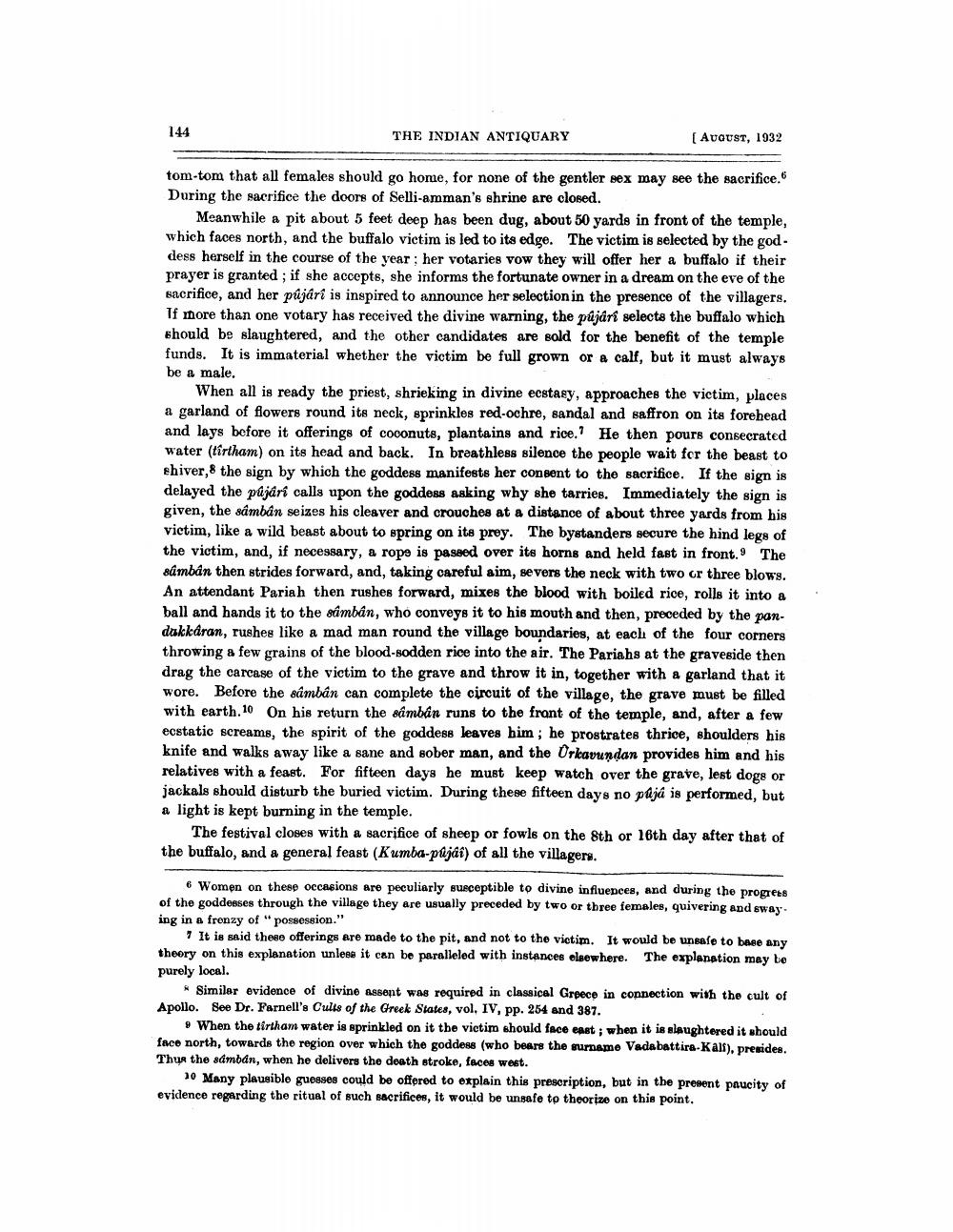________________
144
THE INDIAN ANTIQUARY
(AUGUST, 1932
tom-tom that all females should go home, for none of the gentler sex may see the sacrifice. During the sacrifice the doors of Selli-amman's shrine are closed.
Meanwhile a pit about 5 feet deep has been dug, about 50 yards in front of the temple, which faces north, and the buffalo victim is led to its edge. The victim is selected by the god. dess herself in the course of the year: her votaries vow they will offer her a buffalo if their prayer is granted ; if she accepts, she informs the fortunate owner in a dream on the eve of the sacrifice, and her pújári is inspired to announce her selection in the presence of the villagers. If more than one votary has received the divine warning, the půjári selects the buffalo which should be slaughtered, and the other candidates are sold for the benefit of the temple funds. It is immaterial whether the victim be full grown or a calf, but it must always be a male.
When all is ready the priest, shrieking in divine ecstasy, approaches the victim, places a garland of flowers round its neck, sprinkles red-ochre, sandal and saffron on its forehead and lays before it offerings of coconuts, plantains and rice.? He then pours consecrated water (tirtham) on its head and back. In breathless silence the people wait for the beast to shiver, 8 the sign by which the goddess manifests her consent to the sacrifice. If the sign is delayed the pajari calls upon the goddess asking why she tarries. Immediately the sign is given, the sámban seizes his cleaver and crouches at a distance of about three yards from his vietim, like a wild beast about to spring on its prey. The bystanders secure the hind legs of the victim, and, if necessary, a rope is passed over its horns and held fast in front.9 The sâmbán then strides forward, and, taking careful aim, severs the neck with two or three blows. An attendant Pariah then rushes forward, mixes the blood with boiled rice, rolls it into a ball and hands it to the sámbán, who conveys it to his mouth and then, preceded by the pandakkaran, rushes like a mad man round the village boundaries, at each of the four corners throwing a few grains of the blood-sodden rice into the air. The Pariahs at the graveside then drag the carcase of the victim to the grave and throw it in, together with a garland that it wore. Before the sámban can complete the circuit of the village, the grave must be filled with earth. 10 On his return the sâmbån runs to the front of the temple, and, after a few ecstatic screams, the spirit of the goddess leaves him ; he prostrates thrice, shoulders his knife and walks away like a sane and sober man, and the Orkavundan provides him and his relatives with a feast. For fifteen days he must keep watch over the grave, lest dogs or jackals should disturb the buried victim. During these fifteen days no půjá is performed, but a light is kept burning in the temple.
The festival closes with a sacrifice of sheep or fowls on the 8th or 16th day after that of the buffalo, and a general feast (Kumba-páját) of all the villagers.
6 Women on these occasions are peculiarly susceptible to divino influences, and during the progrets of the goddesses through the village they are usually preceded by two or three females, quivering and sway. ing in a frenzy of "possession."
7 It is said these offerings are made to the pit, and not to the victim. It would be unsafe to base any theory on this explanation unlese it can be paralleled with instances elsewhere. The explanation may be purely local.
Similar evidence of divine essent was required in classical Grpece in connection with the cult of Apollo. See Dr. Farnell's Cults of the Greek States, vol. IV, pp. 254 and 387.
. When the tirtham water is sprinkled on it the victim should face east; when it is slaughtered it should face north, towards the region over which the goddess (who bears the surnamo Vadabattira-Kalf), presides. Thus the samban, when he delivers the death stroke, feces west.
10 Many plausible guesses could be offered to explain this prescription, but in the present paucity of evidence regarding the ritual of such sacrifices, it would be unsafe to theorize on this point.




